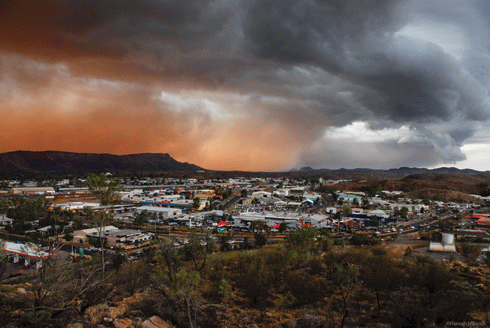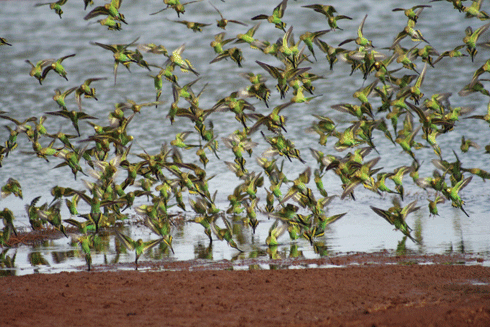
|
Published:
Desert knowledge key to surviving the 21st century
Knowledge about the way life operates in the extreme conditions of Australia’s vast deserts can be applied to a future of new unprecedented constraints. Julian Cribb and Mark Stafford Smith explore how research has been looking to that horizon.

|
|
Our world is changing, bringing increasingly unpredictable weather. Here, a violent storm converges with a dust storm over Alice Springs. Credit: Hannah Millerick
|
Everything that lives in the Australian desert is expert at survival: from the paper daisies that blossom only when sparse rains come, to the coolabah that digs deep to find reliable water, the water birds that migrate between evanescent lakes, the antechinus that stores up fat in its tail, the Aboriginal people who store knowledge of landscape for hundreds of generations in their songs and networks, and the remote outback business that thrives on the internet.
At the heart of this conundrum is the fact that all life in deserts is adapted to cope with – indeed thrive on – uncertainty and scarcity, to depend on resources that vary extremely in both space and time, such as a rare flood followed by prolonged drought, a sudden blaze of life that dies to a low smoulder, or a patch of startling richness in an otherwise barren landscape.
The Australian deserts are reliable only in their unpredictability. Often they are lean in resources, but in some places and at certain times astonishingly bountiful. They teach all their inhabitants ways to survive when the future is bleak and uncertain. They teach about the use of special knowledge, relationships, networks and mobility for survival. They foster new ideas and the evolution of new strategies and skills. They teach us how to live in Australia.
Since European settlement and nationhood, however, Australians have mostly treated the deserts with disdain, protected more by benign neglect and ignorance of their true qualities than by care, as the forces of development have blown across the land. In the world that lies ahead, we will need our deserts and the knowledge that flows from them more, perhaps, than ever in our history.
Our whole world is changing. Vast expanses of our former grain belts and savannahs are actually becoming drier, hotter and more uncertain deserts under human mismanagement and climate change. Water supplies globally are strained or drying up. Forests continue to dwindle. Traditional energy sources are running low or proving hazardous to our future. Vital resources such as fish, phosphorus and certain minerals show signs of exhaustion under the relentless pressures of human demand and population growth. Vast population flows are emerging in the face of mounting pressures.
For more than five millennia humans have attempted to bring certainty to their world, through agriculture, through urbanisation and all the comforts and conveniences of technology. But as we press against the finite bounds of our planet, the signs are that this is changing, that future societies will have to cope – once again – with increased uncertainty, with extremes of climate and with scarcity of vital resources.
The world of the future, in other words, will be more like the world of the deserts – variable, unpredictable, with resources scarce, widely scattered and hard to find. And the rules for human survival will converge on those of the deserts: find ways to cope with uncertainty, or perish.
In recent years, through the Desert Knowledge CRC, there has been much progress in understanding the rules for desert survival and why these are of huge relevance today to all Australians, indeed all people. The unpredictable climate of the deserts and the scarcity of their resources in turn decree sparse populations – of humans, plants or animals – and remoteness, which puts increased emphasis on the knowledge you need for local survival, the networks you need to preserve or exchange it and the resulting rich cultural differences between desert people and others. There is also social uncertainty, against which your society needs strong and specific rules and institutions. (And, in today’s world, there is the increasing powerlessness of desert peoples who are often told by outsiders how to run their lives in ways that contradict the rules for desert survival.)
The main survival strategies used by desert plants, desert animals, desert people and even desert businesses are:
-
To persist in place, like the mulga tree, putting down deep roots to tap inaccessible resources that enable it to ride out the rough times when other things die or leave.
-
To be a refuge dweller, like a fish in a desert mound spring, by choosing to inhabit only a rich spot where resources are (almost) always available.
-
To be ephemeral, like a paper daisy which escapes from scarcity in time, but invests in many seeds that germinate only when the rains come.
-
To be a nomad, like a desert bird or traditional Aboriginal person, following the transient richness across the landscape by keeping on the move and knowing where to go and when.
-
To be an exploiter, like a duck that visits the desert only when Lake Eyre brims, or a mining company that comes only so long as the rich ore body lasts.
Everything that lives in the deserts observes one or several of these strategies. Of late, we have come to realise they also apply to the wider human culture as things become more uncertain there too – to Sydney and Shanghai as well as to Tennant Creek. Their water, food and energy supplies too are at risk. The world’s 200 million migrants and 50 million refugees are obeying one of the basic desert rules: move when the going gets too tough.
We are entering an era when large tracts of the planet are expected to become drier, more extreme and more unpredictable. In this world, climate events never previously recorded in human history will become more common. Like desert plants, we will need risk management strategies that cope with these uncertainties, rather than relying on the complacent delusion that strategies based on past experience will continue to work. All humans are, in that sense, becoming desert explorers.
Yet, for millennia, the deserts have been a fountainhead of innovation. Sciences such as mathematics and astronomy were born among desert peoples. Religions such as Judaism, Christianity, Islam and Zoroastrianism had their genesis in the drylands. The first explosives and the earliest steel came out of the deserts of Central Asia. Cities too first arose in desert regions where people learned to harness water for food production. In short, many essential advances that have influenced human development are themselves the product of a dry landscape whose variability confronts its inhabitants with continual survival challenges, forcing them to use their brains, creativity, contacts, and often to borrow ideas from nature.
Desert knowledge is not solely for the desert itself, important as that is for the three billion humans who will live in the drylands by 2050. Increasingly, as the forces of climate change, population growth and resource scarcity bear down upon humanity, other regions that we do not think of as deserts are starting to resemble them: even our great cities and the fertile plains that feed them are now increasingly short of water, energy and materials.
The wisdom of desert knowledge has a far wider significance than Australians first appreciated. It helps us understand what we must all do if we are to inhabit this dry, unpredictable continent in the long-term. Indeed, it may offer clues to survival in the 21st century, not only for ourselves but, potentially, for much of humanity in dry, uncertain times.
Dry Times: Blueprint for a Red Land, by Mark Stafford Smith and Julian Cribb, is published by CSIRO Publishing: http://www.publish.csiro.au/nid/18/pid/6070.htm.




